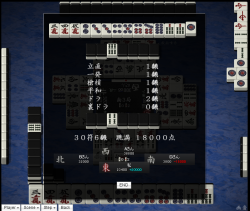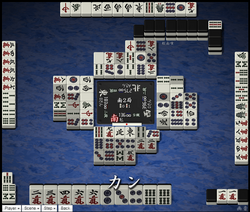Chankan
| Type | Yaku |
|---|---|
| Kanji | 搶槓 |
| English | Robbing a kan |
| Value | 1 han |
| Speed | Dependent |
| Difficulty | Very hard |
Chankan 「搶槓」 is a standard yaku. It is dependent on the usage of kan, where a player may declare ron while a player calls to upgrade a minkou (triple called via pon) to a shominkan (added kan). In other words, if a player is tenpai for a tile used for that specific added kan, then the player may declare a win on that tile.
In almost all cases, players are not allowed to call ron on an ankan (closed kan). The notable exception involves a kokushi tenpai hand, where the last tile needed for the yakuman is called for an ankan. However, the kokushi exception varies on the rules. In some rules, it is disallowed outright.
Hand pattern

Alternatively, this yaku may be referred to as "robbing a kan". Tenpai for chankan must involve a hand, in which one of the waiting tiles has been called as pon by another player. Any tenpai hand works for chankan, even if the hand is otherwise yakuless. As long as the waiting tile has been called for pon earlier and then the player calls for an added kan, this creates a time for a player to claim the added tile for a win. Naturally, waits involving honor tiles do not work in this situation.
While the call for kan reveals additional dora, in the form of kan-dora, the call for chankan interrupts the process for kan. Therefore, additional dora is not revealed.
Limitation
When a player is in tenpai for suukantsu, some rule variations allow invoking a fifth kan to cause a draw. If a fifth kan is allowed in this way, chankan may not apply - the game ends before a chankan can happen.
Machi
As defined, chankan can only be achieved when a minkou (open triplet) is upgraded to a shouminkan. In other words, a player had called pon earlier and then drew the 4th tile, for the kan. If another player is tenpai for that tile, then the player may declare ron. To some degree, the added kan may be viewed as a discard in this case.
So, when it comes to machi (wait patterns), only three basic types can be used for chankan: penchan, kanchan, and ryanmen. To achieve chankan, all four copies of a tile would have needed to been in another player's hand. Therefore, a hand winning with chankan must not have any other copies of the winning tile. This forbids tile patterns involving shanpon and tanki, as these waits require another copy of the tile.
In the case for kokushi musou, the hand is tenpai for kokushi with one of the 13-tile types already paired; and it is waiting for the last tile type for completion. An exception to kan calls involving ankan (closed kan) is made.
Furiten
Under any possible instance of chankan, one player is barred from calling ron and awarded this yaku due to furiten. The initial tile discard was granted for the open call for pon.
Compatibility
^ Ippatsu requires riichi to be of any use.
| RCH | DRI | IPP | SMO | TAN | PFU | IPK | ITT | YAK | SDJ | SDO | TOI | SNA | SNK | CHA | JUN | RPK | SSG | HRO | HON | CHN | CHI | RIN | HAI | HOU | CHK | |
| CHK |
Excluding kokushi musou, chankan requires at least one sequence in the hand, because waits to complete a pair (tanki) or triplet (shanpon) would be impossible. This excludes toitoi, chiitoitsu, and honroutou. Ryanpeikou is also not allowed, due to the tile requirement. A ryanpeikou tenpai would require at least one copy of the winning tile, which prevents the other players from calling kan.
As for rinshan, haitei, houtei, and mentsumo, it is physicially impossible to combine any of these four with chankan. Rinshan, mentsumo, and haitei require a win by self draw, while chankan is always won with ron. In the case of houtei, a player is not allowed to call kan if there are no tiles left in the live wall, so a chankan cannot be the last discard.
Ippatsu
The ippatsu yaku is normally interrupted by a kan call. To call chankan, the opposing player had already called for kan. However, ippatsu is still not interrupted because the whole kan process has not been completed. The entire kan process includes the kan call itself, plus the rinshan draw and the discard afterwards. The chankan win occurs in the middle of that process. So, it is allowable to score both ippatsu and chankan at the same time.
Special cases

Rinshan kaihou
Given the procedure for kan, the chankan takes precedence over rinshan kaihou. Here, the call for a chankan win denies even the drawing of the rinshan tile. Therefore, even the chance for rinshan kaihou is denied.
Kokushi musou
If the rules allow, a special case for kokushi musou exists. This involves a kokushi tenpai hand, where the final tile may be completed with an opponent calling kan with a closed kan using all four of that particular winning tile. Thus, ron may be declared in that instance, involving the special chankan rule. This is the only case where a tile may be taken from an closed kan. However, this particular rule may be subject to variation, which may or may not allow the play to occur.
External links
- Chankan in Japanese Wikipedia
| |||||||||||||||||||||||||||||||
